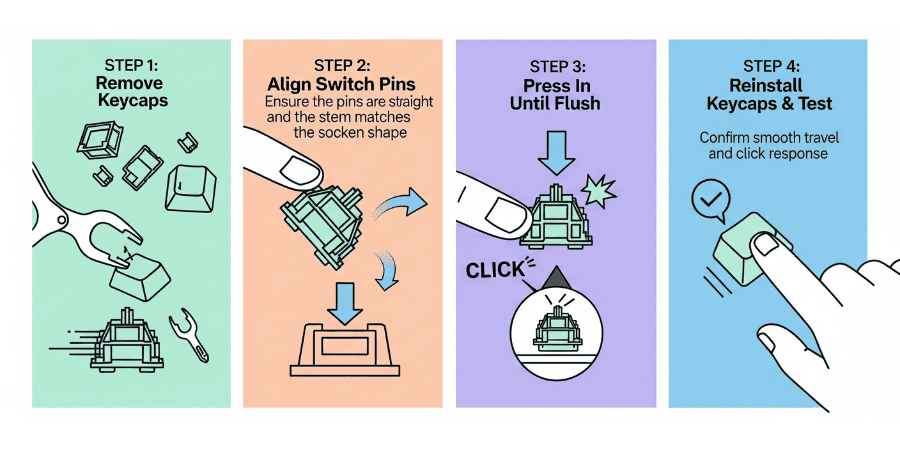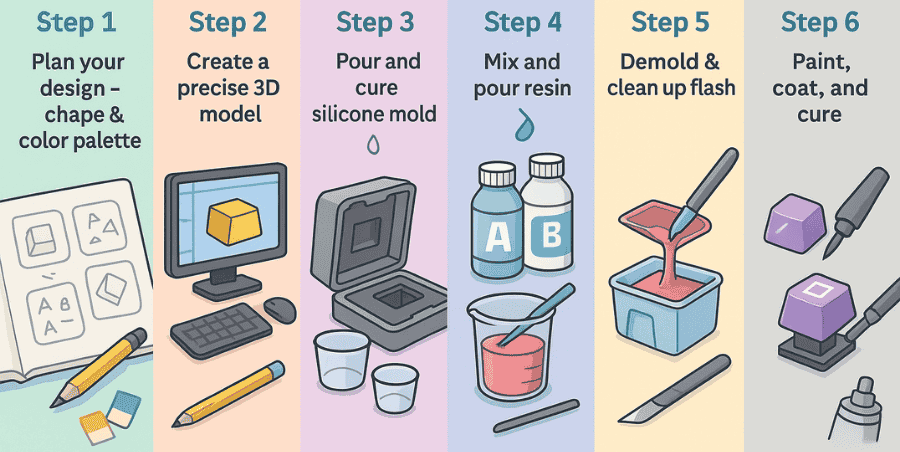Stabilizers are an important part of a mechanical keyboard. They sit under the larger keys, like the spacebar, Enter, Shift, and Backspace, and keep those keys balanced when you press them. Without stabilizers, these keys would feel wobbly and uneven.
There’s nothing more annoying than stock stabilizers that sound dry, rattly, or pingy every time you type. Bad stabs can ruin the typing experience, no matter how good your switches or keycaps are.
On the other hand, well-lubed and properly installed stabilizers make your keyboard feel smooth and consistent. They reduce unwanted noise and give your larger keys a satisfying, stable press. If you care about typing comfort and sound, upgrading or tuning your stabilizers is one of the most important steps you can take.
Keyboard Stabilizers
Keyboard stabilizers come in different shapes and styles. They’re found in almost every keyboard and play a big role in making larger keys feel steady and comfortable to press. Without them, keys like the spacebar or Enter would feel shaky and unpleasant. That’s why stabilizers are so important for both casual users and keyboard enthusiasts.
There are a few main types of stabilizers: screw-in, snap-in (also called plate-mounted), and the less common Costar type. Each type has its own design and mounting method.
- Screw-in stabilizers – These are screwed directly into the keyboard PCB. They’re considered the most secure option and are popular in custom keyboards because they stay firmly in place and reduce wobble.
- Snap-in stabilizers (PCB-mounted) – These clip directly into the PCB without the need for screws. They’re easier to install but can sometimes feel less stable than screw-ins.
- Plate-mounted stabilizers – These attach to the metal plate layer that sits between the switches and PCB. Many pre-built keyboards use this type since they’re simple and inexpensive.
- Costar stabilizers – A less common style that uses a plastic bar and wire guides to support the keycap. They can feel smooth when tuned properly but are harder to install and swap keycaps with.
Cherry-style stabilizers (used in screw-in and snap-in designs) are the most common in custom builds because they’re easier to mod and tune. Costar stabilizers are mostly found in older or budget keyboards and are less favored today.
Durock Stabilzers
The Durock V2 stabilizers come in two versions: clear and smoky. Both are screw-in stabilizers, which means they are mounted directly onto the PCB with screws for a more secure fit. This design makes them sturdier and less prone to wobbling compared to clip-in or plate-mounted stabilizers.
Many keyboard enthusiasts prefer Durock V2 stabilizers because they’re well-made, smooth, and require less tuning out of the box. The clear version has a clean, transparent look, while the smoky version adds a darker, stylish finish to match different keyboard themes.
Housing materials of the stabilizers
Durock V2 stabilizers are made from durable Nylon PA plastic, giving them strength and a smooth feel. They come pre-clipped, which saves you time since you don’t need to cut the feet yourself to prevent unwanted key wobble. The wires and screws are gold-plated steel, which not only makes them stronger but also helps reduce corrosion over time.
One of the best parts is that they include washers in the kit. These washers should always be used during installation, as they prevent metal parts from touching the PCB and causing electrical shorts. This small detail adds to their reliability and makes them safer to use in custom builds.
Lubing of Stabilizers
The first step is to balance your stabilizer wires. Place them on a perfectly flat surface, like glass, to check if they sit evenly. Glass works best because it’s always level. If a wire is bent, it can cause rattling during use, so make sure they’re straight before moving on.
Next, you’ll want to lubricate the stabilizers. A semi-thick lubricant, such as Krytox 205g0, works really well. Use a small brush to apply the lube carefully to the inside of the stabilizer housings and along the sides of the stabilizer stems. This reduces friction and helps the stabilizers move smoothly without that annoying rattle or scratchy feel.
Conclusion
Sometimes even after doing a good job with lubing, the bigger keys like the spacebar, shift, or enter can still feel rattly. If that happens, don’t just blame the stabilizers take a closer look at your keycaps. If the larger keycaps are not flat or level, that unevenness can cause persistent rattle and even a bit of pinging sound when you type.
This is why it’s important to check both the stabilizers and the keycaps. Well-lubed stabilizers paired with properly seated, level keycaps give you the smoothest experience. Once both are tuned right, your keyboard will feel tighter, sound cleaner, and be far more satisfying to use.
That wraps up the basics of Durock stabilizers. Hopefully, this guide gave you useful insights to get rid of annoying rattle and improve your overall typing feel.
FAQ’s
Do Durock stabs need to be clipped?
Durock V2 stabilizers are screw-in PCB mount stabilizers. They’re ready to use out of the box and don’t need clipping, which makes installation easier.
Are cherry clip-in stabilizers good?
Cherry clip-in stabilizers are budget-friendly and relatively easy to mod. They fit a wide range of builds, especially in cases where screw-in stabilizers may not work. This makes them a solid choice for beginners and budget builds.
What is the difference between clear and black staebies?
There are clear differences between black and clear stabilizers. The nylon (black) version feels firmer and tighter, which gives more control. The polycarbonate (clear) version feels a bit looser but offers a smoother downstroke, making it more comfortable for some users.
What is the best dielectric grease for keyboard stabs?
One of the most popular lubes for keyboard stabilizers is Krytox 205g0, which is also great for linear switches. For stabilizers, dielectric grease from Permatex is another well-recommended option. When it comes to tactile switches, Krytox 205g0 works too, but it’s important to avoid lubing the legs, as this can reduce the tactile bump.
Curious how you can supercharge your keyboard’s firmware? Explore our breakdown of What are VIA and QMK for Mechanical Keyboards?.



